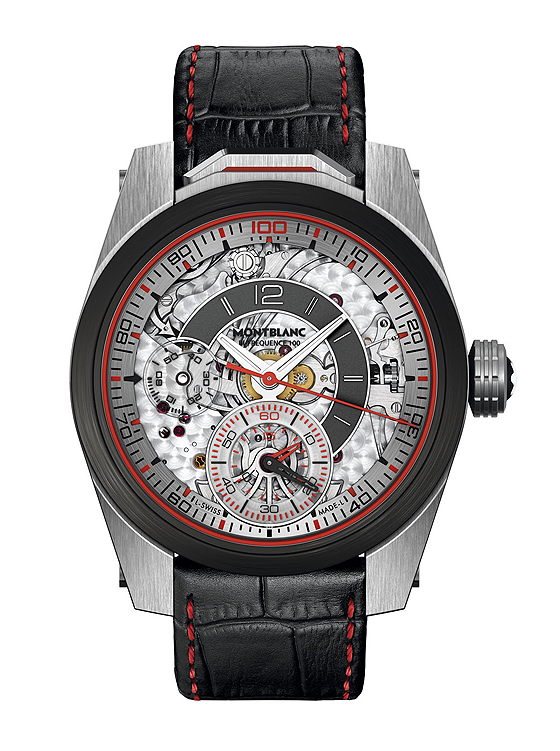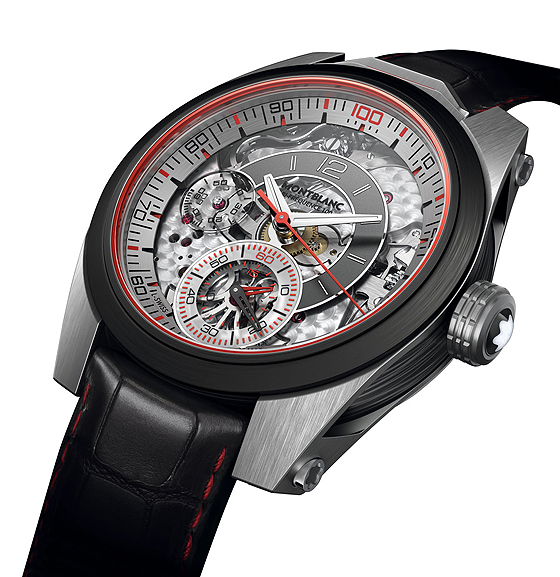Montblanc unveiled the Montblanc Timewalker Chronograph 100, a chronograph Breitling replica watches sale capable of measuring elapsed times to 1/100 second, at the 2014 SIHH watch fair in Geneva. Here are five pertinent things you should know about this innovative timepiece from Montblanc.
1. It comes from a manufacture with an impressive chronograph pedigree.
The historic Minerva Manufacture in Villeret, which would later become part of Montblanc, was renowned for its expertise in making chronograph timepieces. In 1916, it launched one of the first mechanical stop fake Breitling watches able to measure times to 1/100th of a second. Later versions of this timepiece also included a chronograph hand that completed an entire 360° sweep of the dial in just one second. The Montblanc TimeWalker Chronograph 100, a modern iteration of these groundbreaking timepieces, applies and updates this technology with its newly developed manufacture Caliber MB M66.25.
2. The watch has one movement but two balances.
Montblanc’s first big challenge in making a watch that measures intervals with 100th-of-a-second precision was that its movement required a balance that vibrates at a frequency of 360,000 vph (50 hertz). In traditional chronograph new Breitling replica watches, one balance drives both the time display and the chronograph mechanism. Activating the “start” function creates a connection between the going train and the chronograph, which is severed when the “stop” function is triggered. Conventional chronograph calibers have a frequency of only 2.5 to 4 hertz.
The solution developed by the cheap Breitling replica watchmakers in Villeret was to incorporate two balances into the movement — a large, heavy screw balance, beating at a traditional 18,000 vph (2.5 Hz) to ensure the precise rate of the going train, and a smaller balance, with the much higher frequency of 360,000 vph (50 Hz) to regulate the chronograph function.
Instead of being in constant motion, the separate balance for the chronograph starts to vibrate only when the “start” function is activated by a flexible, steel plate mounted behind the arrowhead of the chronograph rocker. When the “stop” function is triggered, the plate stops the smaller balance and holds it in place until the next elapsed-time measurement begins.
The chronograph function has its own barrel, which stores enough energy to measure intervals up to 45 minutes long. However, this limit can be extended indefinitely by turning the crown counterclockwise while the chronograph is running, thus adding fresh energy to its devoted barrel. The going train for the time display draws its energy from a second barrel, which stores a 100-hour power reserve.

3. It has a patented control system with a two-level column wheel and two return-to-zero mechanisms.
Montblanc devised a patented mechanism with an innovative column-wheel control and a new zero-return solution for the central 100ths-of-a-second hand. A two-level column-wheel separates the functional level for starting and stopping the chronograph from the zero-return level for the elapsed-time counters. The column-wheel has four narrow pillars and four broad ones, with alternately higher and lower switching levels positioned between them. The higher level controls the chronograph rocker: its arrowhead carries the slender steel lamella that starts and stops the finely toothed 50-Hz balance.When the chronograph is switched on, the column wheel sends an impulse to the chronograph rocker, which moves away from the high-frequency balance and transfers the impulse, via the steel lamella at its tip, to the balance, which immediately starts vibrating at 360,000 vph. When a time measurement stops, the column wheel moves the chronograph rocker toward the chronograph’s balance so that the steel lamella presses against the balance’s rim, stopping both the balance’s vibrations and the progress of the chronograph’s elapsed-time hands. The lower level of the column wheel is the switching plane for the beak of the heart-lever. This lever returns to zero the 60-elapsed-seconds hand, which is connected to the heart-lever of the 15 elapsed-minutes counter. Heart-levers and heart-cams act in the usual way to return these two counters to their zero positions.The zero-return of the 1/100-second hand occurs in a different, more innovative manner. The 1/100-second wheel has a disk with a catch. While the chronograph is running, the heart-lever of the seconds-counter wheel presses a small, arrowhead-shaped lever with a barb away from this catch. When the chronograph hands are returned to zero, the heart-lever releases the smaller lever and a spring then presses the lever against the wheel with the catch. The 1/100th-second hand is free to complete its sweep until it reaches its zero position, where it stops because the catch of its zero-return disk engages with the barb of the zero-return lever.
4. The case materials come from the world of auto racing.
The tripartite case of the Montblanc Timewalker Chronograph 100 combines a titanium and steel bezel, coated with a layer of highly scratch-resistant DLC (diamond-like carbon); a screwed titanium caseback with a sapphire window; and a case middle incorporating titanium and carbon fiber. Instead of simply gluing a carbon fiber shell over the titanium piece, Montblanc designed the case middle as a seamless, complexly structured cocoon. In this process, several dozen layers of carbon fiber, with the fibers in each layer oriented at 90° to those in the one below it, are fused together with artificial resin at high temperature and under 10 tons of pressure to produce a compact carbon-fiber block. The case’s round sheath is stamped perpendicularly to the carbon-fiber layers to form a seamless “monobloc” which is then tightly stretched over the titanium middle piece. The monobloc’s surface has an atypical (for carbon fiber) horizontally striped pattern rather than the material’s typically uniform texture. The resulting case is lightweight yet very robust. The middle piece of the case is clamped between two pierced longitudinal titanium brackets, which transition into the characteristic skeletonized lugs of the Montblanc TimeWalker collection.
The large, crosswise-fluted crown is also made of titanium and topped by an inset mother-of-pearl Montblanc emblem. The crown is employed for manual winding in both directions: clockwise for winding the replica Cartier watch’s timekeeping functions, counterclockwise for the chronograph function. In a nod to the Minerva stopwatch from 1916, the chronograph pusher is located in an unconventional position, at 12 o’clock. Auto racing influence is also evident in the black alligator-leather strap with red contrast stitching and the titanium pronged buckle.

5. The clear sapphire dial allows you to see all this technology at work.
The dial of the Montblanc Timewalker Chronograph 100 is made of transparent sapphire crystal — surrounded by a horizontally satin-finished flange calibrated with a 1/100-scale and bearing a red “100” at 12 o’clock — and offers an unobstructed view of Montblanc Caliber MB M66.25. Among the details on display are the column wheel near 12 o’clock, which advances by one increment each time the chronograph pusher is triggered, and the components of the bidirectional winding mechanism at 3 o’clock.
The current time is displayed on an anthracite-gray hour scale framed in silver, which is interrupted by two sapphire subdials, one at at 9 o’clock for the running seconds and the other at 6 o’clock for the chronograph’s 60 elapsed seconds and 15 elapsed minutes. The “lanceolate” hour and minute hands are inlaid with Super-LumiNova. The large, central chrono counter hand, which is made of lightweight aluminum and coated with red lacquer, completes one rotation per second. The chronograph subdial has two concentric scales, each swept by its own hand: the longer black hand counts 60 elapsed seconds on the outer scale, which is marked with Arabic numerals, while the shorter red hand counts 15 elapsed minutes on the inner scale.
Harking back to classical Minerva movements of yesteryear, this one also boasts numerous hand-decorated finishes, which the watch’s owner can admire through the sapphire caseback window. Plates, bridges and steel parts are manually fabricated and decorated with circular graining and/or Geneva waves. Edges are manually bevelled, bevels are hand-polished and flanks are brush-finished. Each balance spring is individually hand-counted. The functional surfaces of the chronograph rockers and levers are abraded to match each other with tolerances in the 1/100th-millimeter range, and the ruby pallet-stones are finely adjusted. One can also Breitling replica watches online the oscillations of both balances.






